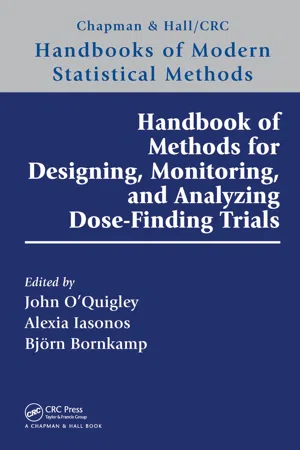
Handbook of Methods for Designing, Monitoring, and Analyzing Dose-Finding Trials
- 306 pages
- English
- ePUB (mobile friendly)
- Available on iOS & Android
Handbook of Methods for Designing, Monitoring, and Analyzing Dose-Finding Trials
About this book
Handbook of Methods for Designing, Monitoring, and Analyzing Dose-Finding Trials gives a thorough presentation of state-of-the-art methods for early phase clinical trials. The methodology of clinical trials has advanced greatly over the last 20 years and, arguably, nowhere greater than that of early phase studies. The need to accelerate drug development in a rapidly evolving context of targeted therapies, immunotherapy, combination treatments and complex group structures has provided the stimulus to these advances. Typically, we deal with very small samples, sequential methods that need to be efficient, while, at the same time adhering to ethical principles due to the involvement of human subjects.
Statistical inference is difficult since the standard techniques of maximum likelihood do not usually apply as a result of model misspecification and parameter estimates lying on the boundary of the parameter space. Bayesian methods play an important part in overcoming these difficulties, but nonetheless, require special consideration in this particular context. The purpose of this handbook is to provide an expanded summary of the field as it stands and also, through discussion, provide insights into the thinking of leaders in the field as to the potential developments of the years ahead. With this goal in mind we present:
- An introduction to the field for graduate students and novices
- A basis for more established researchers from which to build
- A collection of material for an advanced course in early phase clinical trials
- A comprehensive guide to available methodology for practicing statisticians on the design and analysis of dose-finding experiments
- An extensive guide for the multiple comparison and modeling (MCP-Mod) dose-finding approach, adaptive two-stage designs for dose finding, as well as dose–time–response models and multiple testing in the context of confirmatory dose-finding studies.
John O'Quigley is a professor of mathematics and research director at the French National Institute for Health and Medical Research based at the Faculty of Mathematics, University Pierre and Marie Curie in Paris, France. He is author of Proportional Hazards Regression and has published extensively in the field of dose finding.
Alexia Iasonos is an associate attending biostatistician at the Memorial Sloan Kettering Cancer Center in New York. She has over one hundred publications in the leading statistical and clinical journals on the methodology and design of early phase clinical trials. Dr. Iasonos has wide experience in the actual implementation of model based early phase trials and has given courses in scientific meetings internationally.
Björn Bornkamp is a statistical methodologist at Novartis in Basel, Switzerland, researching and implementing dose-finding designs in Phase II clinical trials. He is one of the co-developers of the MCP-Mod methodology for dose finding and main author of the DoseFinding R package. He has published numerous papers on dose finding, nonlinear models and Bayesian statistics, and in 2013 won the Royal Statistical Society award for statistical excellence in the pharmaceutical industry.
Frequently asked questions
- Essential is ideal for learners and professionals who enjoy exploring a wide range of subjects. Access the Essential Library with 800,000+ trusted titles and best-sellers across business, personal growth, and the humanities. Includes unlimited reading time and Standard Read Aloud voice.
- Complete: Perfect for advanced learners and researchers needing full, unrestricted access. Unlock 1.4M+ books across hundreds of subjects, including academic and specialized titles. The Complete Plan also includes advanced features like Premium Read Aloud and Research Assistant.
Please note we cannot support devices running on iOS 13 and Android 7 or earlier. Learn more about using the app.
Information
Part II
More Advanced Phase I and Phase I/II Methodology
5
Phase I/II Dose-Finding Designs with Efficacy and Safety Endpoints
CONTENTS
- 5.1 Introduction
- 5.2 Statistical Background
- 5.2.1 Basic concepts
- 5.2.2 A Bayesian formulation
- 5.2.3 Phase I/II trial objectives
- 5.2.4 Adaptive designs
- 5.3 Phase I/II Designs with Bivariate Binary Outcomes
- 5.3.1 Nonparametric designs
- 5.3.2 Parametric model-based designs
- 5.3.2.1 Extensions of the CRM
- 5.3.2.2 Designs based on efficacy{toxicity tradeoff
- 5.3.2.3 Bayesian decision-theoretic designs
- 5.3.2.4 Penalized optimal adaptive designs
- 5.4 More Complex Settings
- 5.4.1 Binary toxicity and continuous efficacy
- 5.4.2 Handling late-onset outcomes
- 5.4.2.1 Using surrogate efficacy outcomes
- 5.4.2.2 Bayesian data augmentation
- 5.4.2.3 Efficacy as a time-to-event outcome
- 5.4.3 Incorporating covariates
- 5.5 Discussion
- References
5.1 Introduction
Table of contents
- Cover
- Half Title
- Title Page
- Copyright Page
- Table of Contents
- Editors
- Preface
- Contributors
- I Phase I designs
- II More advanced Phase I and Phase I/II methodology
- III Phase II Dose-Finding Trials
- Index